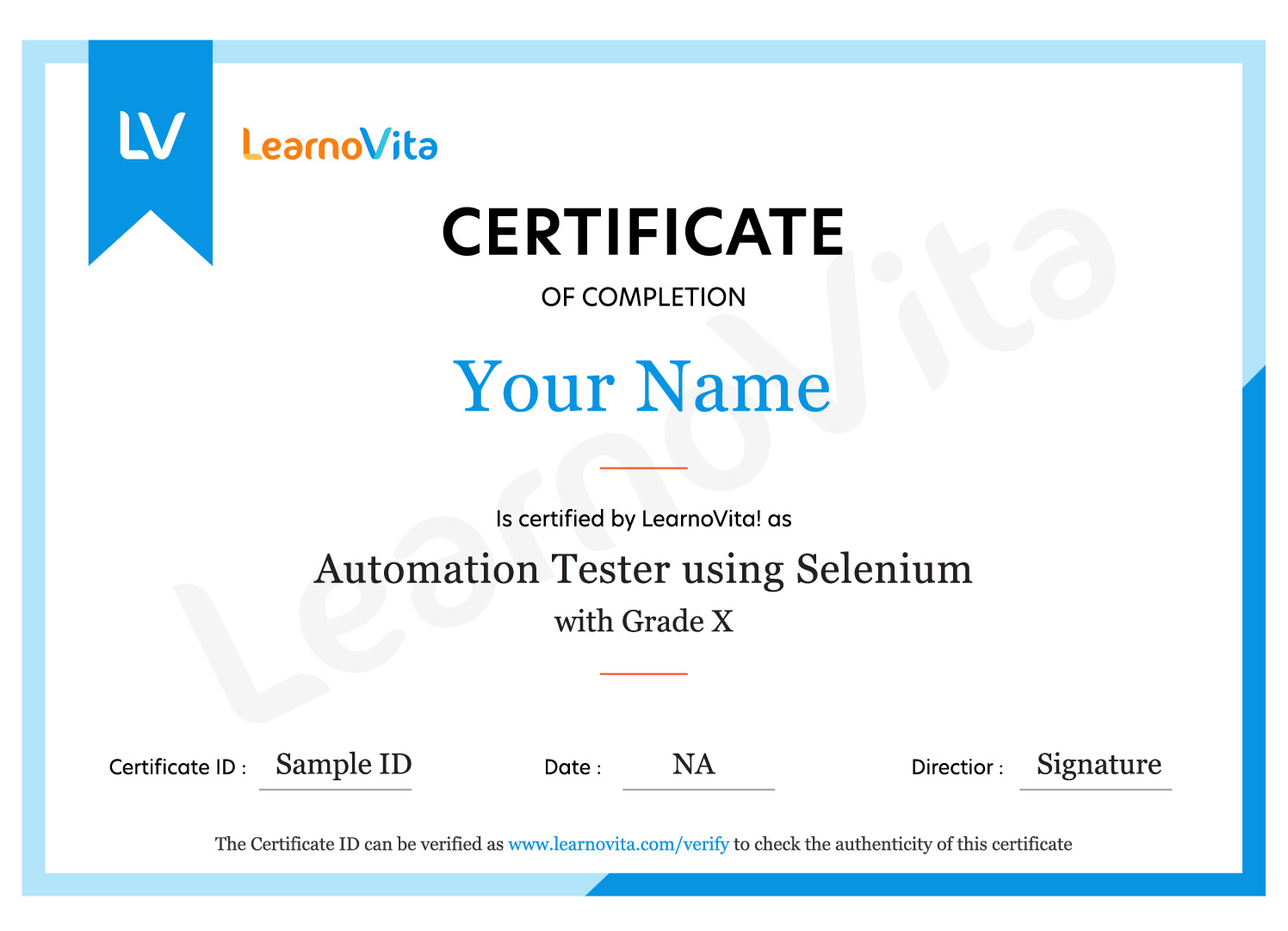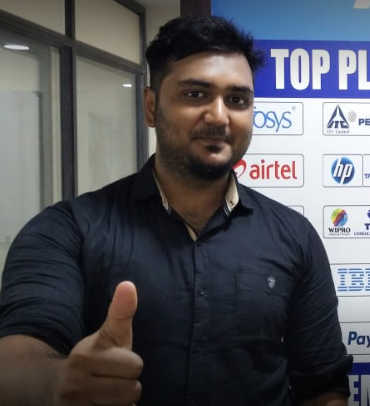What You'll Learn
Start your IT journey with foundational knowledge in networking, security, and hardware essentials.
Learn from expert-led sessions tailored to help you master CompTIA certifications like A+, Network+, and Security+.
Understand real-world IT scenarios through practical labs and hands-on training modules.
Strengthen your problem-solving skills to troubleshoot and manage IT systems efficiently in CompTIA Course in Chennai.
CompTIA Training in Chennai equips you with globally recognized skills for a thriving tech career.
Advance from beginner to expert with structured learning paths designed to match current industry needs.
CompTIA Training Objectives
- It is smarter to receive A+ certification first before the company embarked on it, thus according to CompTIA.
- The A+ offers you an excellent basis for other CompTIA designation such as Server+, but if you have a correct computer background you will skip it.
- The scope of CompTIA has grown immensely.
- The pandemic has caused a tremendous dynamic shift in the world.
- Digitization has brought the world by violence and India was no different.
- Businesses and companies were forced to transform their performance models and adopt virtual images and remote working arrangements.
- Now, the number of online users and companies has increased exponentially and with that, have developed cybercrimes.
- This has called for a more reliable digital environment for every user. Data breach, in common, costs millions of dollars to the industry.
- The easiest way to prove your career is to be licensed. Nine out of ten managers agree that prerequisites are essential to finding the right workplace person.
- In addition, IT-certified persons are more likely than non-IT certified persons to be advertised.
Expect Success with CompTIA Security+ Certification
- The CompTIA Security+ job positions are classified by the U.S. Bureau of Labor Statistics as infrastructure and software system administrators.
- By 2026, there will be an increase in the number of workers in this group by more than six percent. In 2017, the mean pay was 81.100 dollars.
- Ability to operate methodically and is very detail-oriented
- Eagerness to dig into technical issues and examine them from all parties
- Enthusiastic and extremely adaptable
- Strong analytical and diagnostic jobs
- Demonstrated skills in change and collaboration
- Keep a modern understanding of vulnerabilities from the Internet
- Keeping awareness and understanding of contemporary standards, methods, procedures, and methods
- Experience to get the job done
- The prerequisites include basic Computer and programming knowledge. Additionally, knowledge of C and C++ language is an added advantage to learn CompTIA Programing language from Advance CompTIA Course in Coimbatore.
- It is not required but if you get this certification, it will do extraordinary advancement in your profession.
- Course is one of these certifications which are intended to provide people involved with certain skills that fall under the classification of Course.
- The certification is an entry-level certification that is taken to enter the cloud of knowledge technology as a fundamentalist.
- The qualifiers of this program can work as a computer technician or the one who can control the management of an operating system.
- CompTIA Security+ is one of the various popular entry-level security certifications in the business.
- As a vendor-neutral and regular certification, you can be located all over the world after you control the CompTIA Security+ certification.
- The Security+ tests your basic abilities and experience in network protection, knowledge security, access control, running the machines, and more.
- In terms of job applicants, the CompTIA Security+ can surely stand as one of the most notable security certifications.
- The areas that you can get after receiving CompTIA Security+ certified will frequently be entry-level jobs.
- Vendor-Neutral Certification
- Prerequisites and Needed Experience
- Globally Accepted Certification.
- Tremendous Career Opportunity
- Higher PayScale
- Opportunity to Catch up Government Work.
Benefits of CompTIA Security+ Certification for Security Professionals :
- CompTIA is widely used to describe cutting-edge and customized applications for web or mobile platforms and is the stepping stone for individuals hoping to advance their mobile development professions.
- The professionals exceeding in CompTIA can opt for a Career in Big Data, as Hadoop, the most successful Big Data architecture framework, uses CompTIA in its designing and construction.
- The requirement for certified CompTIA developers is always higher, with salaries averaging more than $ 125,000 per year.
Request more informations
Phone (For Voice Call):
+91 89258 75257
WhatsApp (For Call & Chat):
+91 89258 75257
CompTIA Course Benefits
The CompTIA Certification Course in Chennai delivers in-depth IT knowledge with a focus on industry-recognized certifications like A+, Network+, and Security+. Build real-world technical skills through interactive labs and expert-led guidance, preparing you for today’s IT challenges. Gain hands-on experience with a dedicated CompTIA internship in Chennai, designed to bridge classroom learning with workplace demands. Benefit from 100% placement support, opening doors to top roles in IT support, networking, and cybersecurity.
- Designation
-
Annual SalaryHiring Companies
About CompTIA Certification Training
Our CompTIA Training in Chennai offers a budget-friendly path to gain core IT skills in networking, cybersecurity, and system troubleshooting. The CompTIA course fees are designed to be accessible while delivering high-quality, industry-relevant content. Build job-ready skills through practical labs and guided mentorship to excel in today’s competitive IT landscape. Gain hands-on experience with real-time CompTIA projects in Chennai for practical industry exposure.
Top Skills You Will Gain
- Network Fundamentals
- Hardware Troubleshooting
- Cybersecurity Essentials
- Operating Systems
- Cloud Computing
- System Configuration
- Threat Detection
- Technical Support
12+ CompTIA Tools
Online Classroom Batches Preferred
No Interest Financing start at ₹ 5000 / month
Corporate Training
- Customized Learning
- Enterprise Grade Learning Management System (LMS)
- 24x7 Support
- Enterprise Grade Reporting
Why CompTIA Course From Learnovita ? 100% Money Back Guarantee
CompTIA Course Curriculam
Trainers Profile
CompTIA course is just like a spark in your IT career. CompTIA Training in Chennai signifies that the certified individual possesses the knowledge and skills essential for a successful entry-level computer service technician, as defined by experts from companies across the industry.
Syllabus of CompTIA Course Download syllabus
- Features of CompTIA
- Simple
- Secure
- Portable
- Robust
- Multithreading
- Platform-Independent
- Distributed.
- Dynamic
- New Features of CompTIA 8
- Introducing CompTIA Environment
- CompTIA Development Kit
- CompTIA Platforms
- CompTIA Virtual Machine
- CompTIA API
- CompTIA Programs
- Installing CompTIA
- What about CLASSPATH?
- CompTIA’s Reserve Words
- Starting a CompTIA program
- Line 1—public class App
- Line 2—public static void main(String[] args)
- Line 3—System.out.println(“Hello from CompTIA!”);
- Compiling Code 15
- Compiling Code: Using Command-Line Options
- Cross-Compilation Options
- Compiling Code: Checking for Deprecated Methods
- Running Code
- Running Code: Using Command-Line Options
- Commenting Your Code
- Importing CompTIA Packages and Classes
- Finding CompTIA Class with CLASSPATH
- Summary
- Variables
- Data Typing
- Arrays
- Strings
- What Data Types are Available?
- Creating Integer Literals
- Creating Floating-Point Literals
- Creating Boolean Literals
- Creating CharLearnoVitar Literals
- Creating String Literals
- Creating Binary Literals
- Using Underscores in Numeric Literals
- Declaring Integer Variables
- Declaring Floating-Point Variables
- Declaring CharLearnoVitar Variables
- Declaring Boolean Variables
- Initializing Variables Dynamically
- Conversion between Data Types
- Automatic Conversions
- Casting to New Data Types
- Declaring One-Dimensional
- Creating One-Dimensional Arrays
- Initializing One-Dimensional Arrays
- Declaring Multi-Dimensional Arrays
- Creating Multi-Dimensional Arrays
- Initializing Multi-Dimensional Arrays
- Creating Irregular Multi-Dimensional Arrays
- Getting an the Length of an Array
- Understanding General Form of Static Import
- Importing Static Members
- The String Class
- Getting String Length
- Concatenating Strings
- Getting CharLearnoVitars and Substrings
- Searching For and Replacing Strings
- Changing Case in Strings
- Checking for Empty String
- Formatting Numbers in Strings
- The StringBuffer Class
- Creating StringBuffers
- Getting and Setting StringBuffer Lengths and Capacities
- Setting CharLearnoVitars in String Buffers
- Appending and Inserting Using StringBuffers
- Deleting Text in StringBuffers
- Replacing Text in String Buffer
- Using the Wrapper Class
- Autoboxing and Unboxing of Primitive Types
- Learning the Fundamentals of Varargs Methods
- Overloading Varargs Methods
- Learning the Ambiguity in Varargs Methods
- Using Non-Reifiable Formal Parameters
- Operators
- Conditionals
- Loops
- Operator Precedence
- Incrementing and Decrementing (++ and --)
- Unary NOT (~ And !)
- Multiplication and Division (* and /)
- Modulus (%)
- Addition and Subtraction (+ and -)
- Shift Operators (>>, >>>, and <<)
- Relational Operators (>, >=, <, <=, ==, and !=)
- Bitwise and Bitwise Logical AND, XOR, and OR (&, ^, and /)
- Logical (&& and ||)
- The if-then-else Operator
- Assignment Operators (= and [operator]=)
- Using the Math
- Changes in the Math Class
- Class StrictMath
- Comparing Strings
- The if Statement
- The else Statement
- Nested if
- The if-else Ladders
- The switch Statement
- Using Strings in switch Statement
- The while Loop
- The do-while Loop
- The for Loop
- The for-each Loop
- Supporting for-each in Your Own Class
- A (Poor) Solution
- Significance of for-
- Nested Loops
- Using the break Statement
- Using the continue Statement
- Using the return Statement
- Summary
- The Control Overview of a Class
- Working with Objects
- Working with Methods
- Defining Default Methods
- Working with Constructors
- Using Default Constructor
- Using Parameterized Constructors
- Exploring Packages
- Studying the Types of Packages
- Importing Packages
- Using Access Specifiers
- Working with Streams API
- Stream API Overview
- Collection and Stream
- Commonly Used Functional Interfaces in Stream
- CompTIA.util.Optional
- Aggregate Operations
- Working with Time API
- Understanding Encapsulation
- Understanding Abstraction
- Understanding Inheritance
- Understanding the final Keyword
- Preventing Inheritance
- Declaring Constant
- Preventing Method Overriding
- Implementing Interfaces
- Working with Lambda Expressions
- Method References
- Using Lambda Expressions
- Implementing Abstract Classes and Methods
- Difference between Abstract Classes and Interfaces
- Implementing Polymorphism
- Understanding the Static Polymorphism
- Understanding the Dynamic Polymorphism
- Summary
- Streams, Readers and Writers
- Essentials in NIO
- Buffers
- Channels
- Charsets and Selectors
- Enhancements in NIO with CompTIA 8
- The Path Interface
- The Files Class
- The Paths Class
- The File Attribute Interfaces
- The FileSystem Class
- The FileSystems Class
- The FileStore Class
- Prospects of NIO
- Working with Streams
- The InputStream Class
- The OutputStream Class
- The ByteArrayInputStream Class
- The ByteArrayOutputStream Class
- The BufferedInputStream Class
- The BufferedOutputStream Class
- The FileInputStream Class
- The FileOutputStream Class
- Working with the Reader Class
- Working with the Writer Class
- Accepting Input from the Keyboard with the InputStreamReader Class
- Working with the OutputStreamWriter Class
- Working with Files
- Using the File Class
- Using the FileReader Class
- Using the FileWriter Class
- Working with the RandomAccessFile Class
- Working with CharLearnoVitar Arrays
- Using the CharArrayReader Class
- Using the CharArrayWriter Class
- Working with Buffers
- Using the BufferedReader Class
- Using the BufferedWriter Class
- Working with the PushbackReader Class
- Working with the PrintWriter Class
- Working with the StreamTokenizer Class
- Implementing the Serializable Interface
- Working with the Console Class
- Working with the Clipboard
- Working with the Printer
- Printing with the Formatter Class
- Using the System.out.printf() Method
- Using the String.format() Method
- Formatting Dates Using the String.format() Method
- Using the CompTIA.util.Formatter Class
- Scanning Input with the Scanner class
- Summary
- Exception Handling Techniques
- Rethrowing Catched Exception with Improved Type Checking
- Built-in Exceptions
- User-Defined Exceptions
- Summary
- Using Threads in CompTIA
- Life Cycle of a Thread
- Synchronization of Threads
- Multithreaded Custom Class Loader
- Getting the Main Thread
- Naming a Thread
- Pausing a Thread
- Creating a Thread with the Runnable Interface
- Creating a Thread with the Thread Class
- Creating Multiple Threads
- Joining Threads
- Checking if a Thread Is Alive
- Setting Thread Priority and Stopping Threads
- Synchronizing
- Communicating between Threads
- Suspending and Resuming Threads
- Creating Graphics Animation with Threads
- Eliminating Flicker in Graphics Animation Created Using Threads
- Suspending and Resuming Graphics Animation
- Using Double Buffering
- Simplifying Producer-Consumer with the Queue Interface
- Implementing Concurrent Programming
- Simplifying Servers Using the Concurrency Utilities
- Knowing Various Concurrency Utilities
- Learning about the CompTIA.util.concurrent Package
- Learning about the CompTIA.util.concurrent.locks Package
- Learning about the CompTIA.util.concurrent.atomic Package
- Summary
- The Collection Interfaces
- The Collection Classes
- The Map Interfaces
- The Map Classes
- Collections Framework Enhancements in CompTIA SE 8
- Using the Collection Interface
- The Queue Interface
- The List Interface
- The Set Interface
- The SortedSet Interface
- Using the Collection Classes
- Using the Comparator Interface
- Using the Iterator Interface
- Using the ListIterator Interface
- Using the AbstractMap Class
- Using the HashMap Class
- Using the TreeMap Class
- Using the Arrays Class
- Learning the Fundamentals of Enumerations
- The Legacy Classes and Interfaces
- Using the Aggregate Operations
- Using the CompTIA.util.function Package
- Summary
- Packages and Interfaces
- JAR Files
- The CompTIA API Package
- The CompTIA.lang Package
- Basics of Annotation
- Other Built-In Annotations
- Creating a Package
- Creating Packages that have Subpackages
- Creating an Interface
- Implementing an Interface
- Extending an Interface
- Using Interfaces for Callbacks
- Performing Operations on a JAR File
- Marker Annotations
- Single Member Annotations
- Summary
- What is CompTIA Bean?
- Advantages of CompTIA Bean
- Introspection
- Persistence
- Customizers
- Understanding CompTIA Beans
- Designing Programs Using CompTIA Beans
- Creating Applets that Use CompTIA Beans
- Creating a CompTIA Bean
- Creating a Bean Manifest File
- Creating a Bean JAR File
- Creating a New Bean
- Adding Controls to Beans
- Giving a Bean Properties
- Design Patterns for Properties
- Using Simple Properties
- Designing Patterns for Events
- Learning Methods and Design Patterns
- Creating Bound Properties
- Giving a Bean Methods
- Giving a Bean an Icon
- Creating a BeanInfo Class
- Setting Bound and Constrained Properties
- Implementing Persistence
- Using the CompTIA Beans API
- Learning the Basics of an Event
- Using the CompTIA Beans Conventions
- Using the Remote Notification and Distributed Notification
- Using Beans with JSP
- Summary
- Basics of Networking
- Sockets in CompTIA
- Client-Server Networking
- Proxy Servers
- Internet Addressing
- Domain Name Service
- Inet4Addresses and Inet6Addresses
- The URL Class
- The URI Class
- URI Syntax and Components
- TCP/IP and Datagram
- Blackboard Assignment Retrieval Transaction
- Understanding Networking Interfaces and Classes in the CompTIA.net Package
- Understanding the InetAddresses
- Caching InetAddress
- Creating and Using Sockets
- Creating TCP Clients and Servers
- Understanding the Whois Example
- Submitting an HTML Form from a CompTIA Program
- Handling URL
- Using the URLConnection Objects
- Working with Datagrams
- Datagrams Server and Client
- Working with BART
- Learning about the CompTIA.security Package
- Summary
- Introducing Events
- Introducing Event Handling
- Working with the Types of Servlet Events
- Developing the onlineshop Web Application
- Introducing Wrappers
- Working with Wrappers
- Summary
- Introducing JSP Technology
- Listing Advantages of JSP over CompTIA Servlet
- Exploring the Architecture of a JSP Page
- Describing the Life Cycle of a JSP Page
- Working with JSP Basic Tags and Implicit Objects
- Working with Action Tags in JSP
- Exploring EL
- Using Custom Tag Library with EL Functions
- Exploring the Need of Filters
- Exploring the Working of Filters
- Exploring Filter API
- Configuring a Filter
- Creating a Web Application Using Filters
- Using Initializing Parameter in Filters
- Manipulating Responses
- Discussing Issues in Using Threads with Filters
- Summary
- Describing the CompTIA EE Application Architecture
- Introducing a Design Pattern
- Discussing the Role of Design Patterns
- Exploring Types of Patterns
- Summary
- Section A: Exploring SOA and CompTIA Web Services
- Overview of SOA
- Describing the SOA Environment
- Overview of JWS
- Role of WSDL, SOAP and CompTIA/XML Mapping in SOA
- Section B: Understanding Web Service Specifications to Implement SOA
- Exploring the JAX-WS 2.2 Specification
- Exploring the JAXB 2.2 Specification
- Exploring the WSEE 1.3 Specification
- Exploring the WS-Metadata 2.2 Specification
- Describing the SAAJ 1.3 Specification
- Working with SAAJ and DOM APIs
- Describing the JAXR Specification
- JAXR Architecture
- Exploring the StAX 1.0 Specification
- Exploring the WebSocket 1.0 Specification
- Describing the JAX-RS 2.0 Specification
- Exploring the JASON-P 1.0 Specification
- Section C: Using the Web Service Specifications
- Using the JAX-WS 2.2 Specification
- Using the JAXB 2.2 Specification
- Using the WSEE and WS-Metadata Specifications
- Implementing the SAAJ Specification
- Implementing the JAXR Specification
- Implementing the StAX Specification
- Introduction to Hibernate
- Hibernate CRUD Operation
- Hibernate Queries and Relationships
- Mapping Relationship with Hibernate
- Introduction to Spring
- Dependency Injection, SpringBean Lifecycle, Wiring and Scope
- Introduction to Spring AOP (Aspect-Oriented Programming)
- Configuring AOP in CompTIA Application using AspectJ Approach
- Spring JDBC Implementation in an Application
- Spring Hibernate Template
- Spring JDBC Transaction Management
- Spring MVC Architecture, Components, and Framework
- Spring MVC Program
Request more informations
Phone (For Voice Call):
+91 89258 75257
WhatsApp (For Call & Chat):
+91 89258 75257
Industry Projects
Career Support
Our Hiring Partner
Request more informations
Phone (For Voice Call):
+91 89258 75257
WhatsApp (For Call & Chat):
+91 89258 75257
Exam & CompTIA Certification
CompTIA Online Training / Class Room:
- Participate and Complete One batch of CompTIA Training Course
- Successful completion and evaluation of any one of the given projects
- Complete 85% of the CompTIA Certification Training
- Successful completion and evaluation of any one of the given projects
- Oracle Certified Associate (OCA)
- Oracle Certified Professional (OCP)
- Oracle Certified Expert (OCE)
- Oracle Certified Master (OCM)
- Learn About the Certification Paths.
- Write Code Daily This will help you develop Coding Reading and Writing ability.
- Refer and Read Recommended Books Depending on Which Exam you are Going to Take up.
- Join LernoVita CompTIA Certification Training in Chennai That Gives you a High Chance to interact with your Subject Expert Instructors and fellow Aspirants Preparing for Certifications.
- Solve Sample Tests that would help you to Increase the Speed needed for attempting the exam and also helps for Agile Thinking.

Our Student Successful Story
How are the CompTIA Course with LearnoVita Different?
Feature
LearnoVita
Other Institutes
Affordable Fees
Competitive Pricing With Flexible Payment Options.
Higher CompTIA Fees With Limited Payment Options.
Live Class From ( Industry Expert)
Well Experienced Trainer From a Relevant Field With Practical CompTIA Training
Theoretical Class With Limited Practical
Updated Syllabus
Updated and Industry-relevant CompTIA Course Curriculum With Hands-on Learning.
Outdated Curriculum With Limited Practical Training.
Hands-on projects
Real-world CompTIA Projects With Live Case Studies and Collaboration With Companies.
Basic Projects With Limited Real-world Application.
Certification
Industry-recognized CompTIA Certifications With Global Validity.
Basic CompTIA Certifications With Limited Recognition.
Placement Support
Strong Placement Support With Tie-ups With Top Companies and Mock Interviews.
Basic Placement Support
Industry Partnerships
Strong Ties With Top Tech Companies for Internships and Placements
No Partnerships, Limited Opportunities
Batch Size
Small Batch Sizes for Personalized Attention.
Large Batch Sizes With Limited Individual Focus.
Additional Features
Lifetime Access to CompTIA Course Materials, Alumni Network, and Hackathons.
No Additional Features or Perks.
Training Support
Dedicated Mentors, 24/7 Doubt Resolution, and Personalized Guidance.
Limited Mentor Support and No After-hours Assistance.
CompTIA Course FAQ's
- LearnoVita is dedicated to assisting job seekers in seeking, connecting, and achieving success, while also ensuring employers are delighted with the ideal candidates.
- Upon successful completion of a career course with LearnoVita, you may qualify for job placement assistance. We offer 100% placement assistance and maintain strong relationships with over 650 top MNCs.
- Our Placement Cell aids students in securing interviews with major companies such as Oracle, HP, Wipro, Accenture, Google, IBM, Tech Mahindra, Amazon, CTS, TCS, HCL, Infosys, MindTree, and MPhasis, among others.
- LearnoVita has a legendary reputation for placing students, as evidenced by our Placed Students' List on our website. Last year alone, over 5400 students were placed in India and globally.
- We conduct development sessions, including mock interviews and presentation skills training, to prepare students for challenging interview situations with confidence. With an 85% placement record, our Placement Cell continues to support you until you secure a position with a better MNC.
- Please visit your student's portal for free access to job openings, study materials, videos, recorded sections, and top MNC interview questions.

- Build a Powerful Resume for Career Success
- Get Trainer Tips to Clear Interviews
- Practice with Experts: Mock Interviews for Success
- Crack Interviews & Land Your Dream Job
Find CompTIA Training in Other Cities
Get Our App Now!

















 Regular 1:1 Mentorship From Industry Experts
Regular 1:1 Mentorship From Industry Experts




